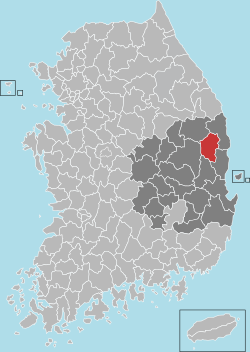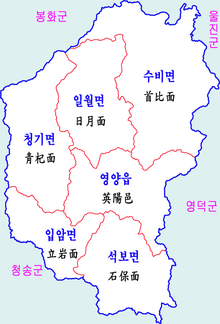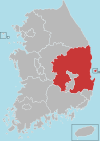Yeongyang County
This article relies largely or entirely on a single source. (May 2018) |
Yeongyang
영양군 | |
|---|---|
| Korean transcription(s) | |
| • Hangul | 영양군 |
| • Hanja | 英陽郡 |
| • Revised Romanization | Yeongyang-gun |
| • McCune-Reischauer | Yŏngyang-gun |
 Location in South Korea | |
| Country | |
| Region | Yeongnam |
| Administrative divisions | 1 eup, 5 myeon |
| Area | |
| • Total | 815.14 km2 (314.73 sq mi) |
| Population (September 2024[1]) | |
| • Total | 15,403 |
| • Density | 21.8/km2 (56/sq mi) |
| • Dialect | Gyeongsang |
Yeongyang County (Yeongyang-gun) is an inland county in the north-eastern area of North Gyeongsang Province, South Korea.
Geography
[edit]An isolated area difficult to access, Yeongyang is sometimes called an "inland island". The county has the lowest population of all counties in North Gyeongsang Province (without Ulleung County), being mountainous with deep ravines, and only 10 percent of land is cultivable.
Local specialties
[edit]The county is famous for its apples and chili peppers, and is home to the Yeongyang Chili Pepper Experimental Station. Since 1984, the county has elected a "Miss Chili Pepper" to represent Yeongyang chili peppers.
Culture
[edit]The area is known as a centre of literature, with the tradition of scholars reading and reciting poetry deep in the mountains, from which have emerged Oh Il-do, Cho Chi-hun and Yi Munyol. Within the county, the Yeondaeam historic temple is located in the village of Samji-Ri.
Administrative divisions
[edit]
Yeongyang County is divided into 1 eup and 5 myeon.
| Name | Hangeul | Hanguk |
|---|---|---|
| Yeongyang-eup | 영양읍 | 英陽邑 |
| Ibam-myeon | 입암면 | 立岩面 |
| Cheonggi-myeon | 청기면 | 靑杞面 |
| Irwol-myeon | 일월면 | 日月面 |
| Subi-myeon | 수비면 | 首比面 |
| Seokbo-myeon | 석보면 | 石保面 |
Twin towns – sister cities
[edit]Yeongyang is twinned with:
References
[edit]- ^ "Population statistics". Korea Ministry of the Interior and Safety. 2024.
External links
[edit]36°40′0″N 129°06′44″E / 36.66667°N 129.11222°E



